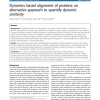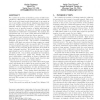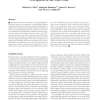951 search results - page 186 / 191 » Suggestions for OWL 3 |
BMCBI
2010
13 years 4 months ago
2010
Background: The dynamic motions of many proteins are central to their function. It therefore follows that the dynamic requirements of a protein are evolutionary constrained. In or...
COMCOM
2011
13 years 4 months ago
2011
In the very active field of complex networks, research advances have largely been stimulated by the availability of empirical data and the increase in computational power needed ...
CORR
2011
Springer
13 years 4 months ago
2011
Springer
We consider the problem of identifying a team of skilled individuals for collaboration, in the presence of a social network. Each node in the input social network may be an expert...
JOCN
2011
13 years 4 months ago
2011
■ The temporal sequence of neural processes supporting figure– ground perception was investigated by recording ERPs associated withsubjectsʼ perceptions of the face–vase fi...
TMM
2011
13 years 4 months ago
2011
Past research on automatic laughter classification / detection has focused mainly on audio-based approaches. Here we present an audiovisual approach to distinguishing laughter fr...



